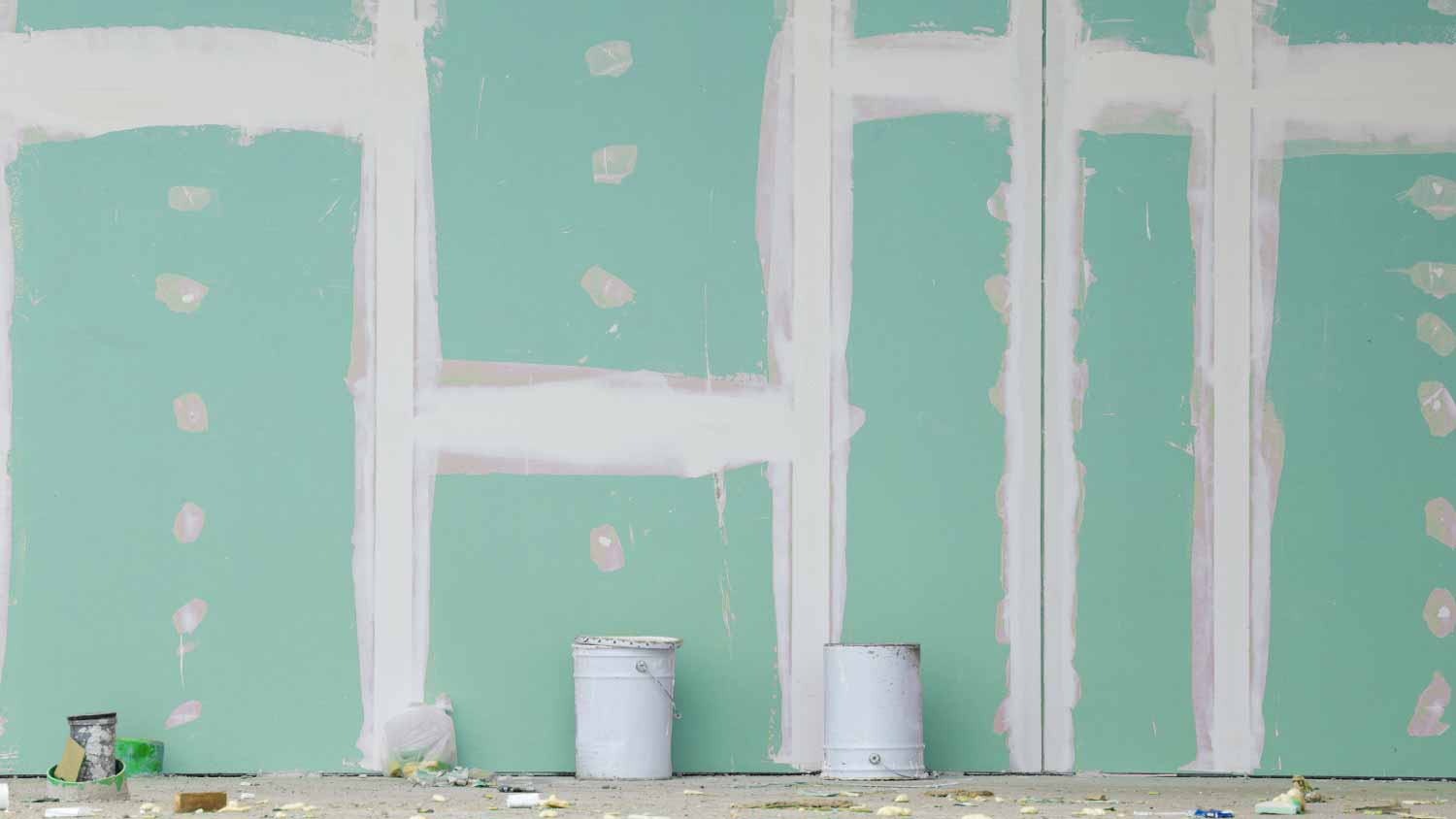
Skim coating drywall is a great alternative to replacement, and is often more affordable. Use this guide to estimate the cost to skim coat walls in your home.
You’ll be a patching pro in no time


Drywall is notorious for collecting dents, holes, and cracks, which can tarnish the look of your home. Even worse? In some cases, drywall damage can compromise your insulation or let pests inside. Thankfully, learning how to patch a hole in drywall is easy—as you’ll see below.
Your kit will come with all of the drywall repair tools you’ll need to patch a small hole (up to 5 inches across), including a putty knife, sandpaper, and spackle. However, it’s also important to grab a pair of safety goggles and a respirator mask to protect your health.
In addition to the tools mentioned above, drywall repair kits also include mesh patches to cover the holes in your wall. Since these patches come in various sizes, you’ll need to know the diameter of the hole you’re patching before purchasing a kit.

Drywall can make a big mess, so we recommend covering your floor and nearby furniture with drop sheets before getting started.
To kick off the drywall repair work, use a damp cloth to wipe down the area around the hole, making sure to get rid of any dirt or dust on the wall. Then, dry everything with a clean cloth.
Using the sandpaper from your kit, sand around the hole to smooth out any uneven edges.
Many drywall patch kits include premixed spackle. If that’s what you have, give it a gentle stir and move to the next step.
Otherwise, if your spackle came in powdered form, mix it with water according to the instructions on the package.
Some kits include a flexible plastic plate that you insert into the hole for extra stability. If you have one of these plates, attach it to the back of the wall.
No matter what kind of kit you have, the next step is often the same: Stick the self-adhesive mesh patch over the hole in your drywall. If the patch is much bigger than the hole, you can trim it with scissors.
Alternatively, if the patch isn’t large enough to cover the entire hole, you’ll need to buy bigger patches. Online retailers and home improvement stores sell individual drywall patches.

Use the putty knife to apply spackle over the mesh, extending it past the patch by an inch on each side. Spread the spackle in a crisscross pattern, making sure to cover the patch completely and feathering the edges to mask the texture of the mesh.
Clean the putty knife in the bucket of water to get rid of any leftover spackle.
Now, you’ll need to exercise a little patience as you wait for the spackle to dry. Depending on your kit, this could take anywhere from 15 minutes to 24 hours. Check your kit’s packaging to find the manufacturer’s drying time recommendation.
Repeat the steps above to apply another layer of spackle on top of the first one. This will be your top layer, so aim to make it as smooth and bump-free as possible.
When you’re done, let it dry according to the manufacturer’s instructions.

When the spackle is dry, use the kit’s sandpaper to sand the area smooth. Wipe the wall with a damp cloth to get rid of any dust.
Use a paintbrush and paint to touch up the patched area. (Note: If you’re patching lots of holes or find that the patched area doesn’t blend in well, it’s better to repaint the entire wall.)
Patching one or two small holes in drywall is a beginner-friendly DIY task. When you tackle this project yourself, your only expense will be the drywall repair kit, which costs between $10 and $30. Meanwhile, hiring a professional to repair small drywall holes costs $20 to $120. Fixing larger holes is often more expensive, ranging from $50 to $200.
With that said, if your drywall is full of holes or in otherwise poor condition, consider hiring a drywall repair pro near you. Depending on the type and extent of the damage, they might have to repair or replace large sections of the drywall.
Cancelled appointment two hours after they were supposed to come for drywall work.
Involved an extensive bathroom remodel, including removing tub & installing walk in shower, new drywall, custome tile work to ceiling, plumbing, etc. Overall, job was done on time and on budget. Nick & his team were very professional and had high attention to detail. Quality was great. Highly...
Fred and his partner did an excellent job and they finished in two days. They replaced the drywall and it is flawless. Fred's workmanship is top notch. Fred is also practical and reliable. He also does hardscaping and can do other types of home improvement projects.
They did really extensive work and did an amazing job. It took about six months altogether, but they did a very good job for our waterworks. Our neighborhood has a lot of older houses that have a kind of like a low basement, and ours was unfinished, and won't do with semi-finished and not in...
I've been around the block myself many times and know most of the lingo, angles, tricks and traps of contracting work on a home. And, I've taken the community school contracting licensing classes and heard contractors discuss openly and candidly trade practices and tales both good and bad. ...
Excellent work; great attention to detail; makes good suggestions but always goes along with what the customer requests; clean and tidy; intelligent; very reasonable rates. I would definitely hire him again for other home projects. He can do a variety of different jobs including: drywall,...
From average costs to expert advice, get all the answers you need to get your job done.

Skim coating drywall is a great alternative to replacement, and is often more affordable. Use this guide to estimate the cost to skim coat walls in your home.

Installing drywall is the most common way to finish your home’s interior. Use this drywall installation cost guide to see what your project is likely to cost.

Drywall texture can create an attractive finish and add dimension to your home’s walls. This guide breaks down the factors that influence the cost to texture drywall.

Whether you want to spruce up a few dents and dings or fix a large surface area, investing in drywall repair costs can return your walls to a smooth, flush look.

You may be wondering if you need plastic behind moisture-resistant drywall. Explore this guide to find the answer and nail your next DIY.

Your drywall reeks, and you’re not sure why. Learn why your drywall smells like poop, and what to do about it.